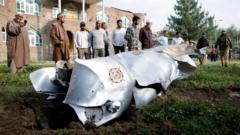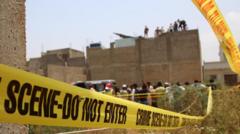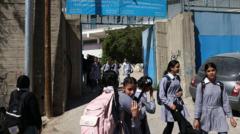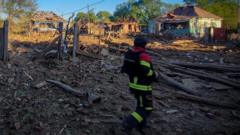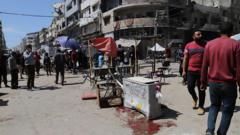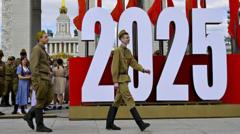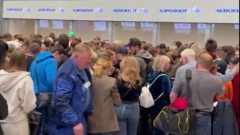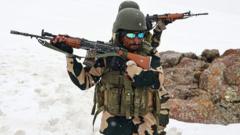The recent ceasefire between Israel and Hamas marks a significant yet uncertain chapter in a conflict that has led to immense human suffering and destruction over the past 15 months. Initiated after a brutal escalation in hostilities, the agreement allowed for the exchange of hostages and prisoners, but raises numerous questions about its sustainability and the broader humanitarian crisis.
**Fragile Ceasefire in Israel-Hamas Conflict: A Turning Point or Temporary Relief?**
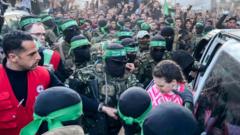
**Fragile Ceasefire in Israel-Hamas Conflict: A Turning Point or Temporary Relief?**
A lengthy ceasefire emerges on the backdrop of a devastating conflict, with implications for hostages, civilians, and political dynamics.
The ceasefire took effect on Sunday amid serious concerns of its potential collapse at the outset, as Hamas initially delayed providing the names of the hostages to be released, causing Israel to temporarily halt the ceasefire. However, once the names were received, they facilitated the release of three Israeli women hostages: Romi Gonen, Doron Steinbrecher, and Emily Damari. In exchange, Israel prepared to release 90 Palestinians from custody.
This fragile truce, if upheld over the next six weeks, aims to allow a total of 33 hostages to be returned while approximately 1,900 Palestinians are expected to be freed. However, the backdrop of uncertainty remains, with Israeli officials reporting that around 97 hostages are still held, many feared dead.
As the ceasefire unfolded, tragic realities persisted in Gaza, where over 46,900 lives have been claimed since the onset of the conflict, primarily civilian. The humanitarian crisis is exacerbated by widespread displacement, with UN officials reporting extensive destruction of infrastructure, leaving many without basic necessities. A resident in Khan Younis expressed the emotional turmoil felt by many Gazans, noting the simultaneous relief of a ceasefire amidst ongoing grief for loved ones lost to the violence.
In Israel, reactions to the ceasefire were mixed, especially within the government. The deal faced criticism from some far-right ministers who viewed it as undermining Israel’s military objectives and refuge efforts against Hamas. National Security Minister Itamar Ben-Gvir was notably vocal about his opposition and resigned from the coalition in protest. Meanwhile, Foreign Minister Gideon Saar recognized the contentious nature of the agreement, emphasizing the moral obligation to secure the release of Israeli hostages.
Internationally, the ceasefire has drawn attention with the involvement of numerous external actors, including the U.S. and Qatari mediators. While glimpses of potential hope arise from the cessation of hostilities, the ground realities in both Israel and Gaza, coupled with the political fallout from the agreement, pose significant challenges to lasting peace.
Despite these challenges, the moment of the hostage release offered a stark contrast to the prevailing conditions. Families reunited with loved ones after enduring immense fear and suffering, as seen with Emily Damari returning to her mother's embrace. Amidst this personal triumph, the ongoing humanitarian needs in Gaza and growing political tensions in Israel add layers of complexity to what this ceasefire signifies for the future of both regions.
The ceasefire's initial success may have brought transient relief and joy, but skepticism remains about its durability and how it will influence broader objective achievements in the conflict, presenting a poignant reality for the people on both sides.
In summary, while the current ceasefire marks a pivotal moment in a protracted conflict, the path forward remains fraught with uncertainty. It reflects not only a temporary respite but also raises critical questions about humanitarian recovery and political accountability in the wake of deep-rooted hostilities.
This fragile truce, if upheld over the next six weeks, aims to allow a total of 33 hostages to be returned while approximately 1,900 Palestinians are expected to be freed. However, the backdrop of uncertainty remains, with Israeli officials reporting that around 97 hostages are still held, many feared dead.
As the ceasefire unfolded, tragic realities persisted in Gaza, where over 46,900 lives have been claimed since the onset of the conflict, primarily civilian. The humanitarian crisis is exacerbated by widespread displacement, with UN officials reporting extensive destruction of infrastructure, leaving many without basic necessities. A resident in Khan Younis expressed the emotional turmoil felt by many Gazans, noting the simultaneous relief of a ceasefire amidst ongoing grief for loved ones lost to the violence.
In Israel, reactions to the ceasefire were mixed, especially within the government. The deal faced criticism from some far-right ministers who viewed it as undermining Israel’s military objectives and refuge efforts against Hamas. National Security Minister Itamar Ben-Gvir was notably vocal about his opposition and resigned from the coalition in protest. Meanwhile, Foreign Minister Gideon Saar recognized the contentious nature of the agreement, emphasizing the moral obligation to secure the release of Israeli hostages.
Internationally, the ceasefire has drawn attention with the involvement of numerous external actors, including the U.S. and Qatari mediators. While glimpses of potential hope arise from the cessation of hostilities, the ground realities in both Israel and Gaza, coupled with the political fallout from the agreement, pose significant challenges to lasting peace.
Despite these challenges, the moment of the hostage release offered a stark contrast to the prevailing conditions. Families reunited with loved ones after enduring immense fear and suffering, as seen with Emily Damari returning to her mother's embrace. Amidst this personal triumph, the ongoing humanitarian needs in Gaza and growing political tensions in Israel add layers of complexity to what this ceasefire signifies for the future of both regions.
The ceasefire's initial success may have brought transient relief and joy, but skepticism remains about its durability and how it will influence broader objective achievements in the conflict, presenting a poignant reality for the people on both sides.
In summary, while the current ceasefire marks a pivotal moment in a protracted conflict, the path forward remains fraught with uncertainty. It reflects not only a temporary respite but also raises critical questions about humanitarian recovery and political accountability in the wake of deep-rooted hostilities.



